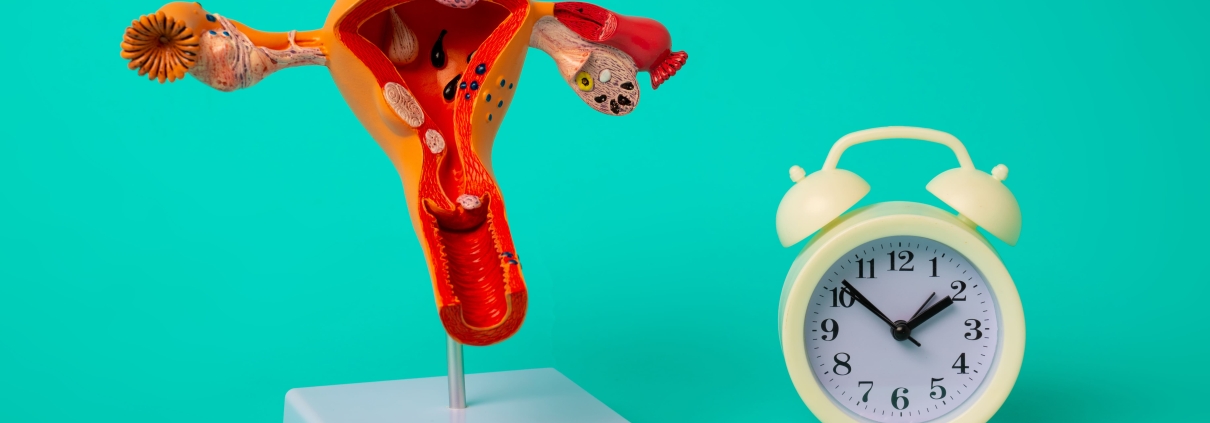Uterine Fibroid Embolisation vs. Medication: Success Rates
When weighing uterine fibroid embolisation vs. medication, success and long-term relief matter most. Uterine fibroid embolisation (UFE) tends to offer more lasting results. Studies show that up to 90% of women who undergo UFE report improvements in heavy bleeding, while pain and pressure symptoms also improve vastly — with relief reported in roughly 74% to 85% of cases.
Medication, on the other hand, largely includes hormonal therapy or drugs like GnRH agonists. These options can help lower symptoms temporarily. But once you stop taking them, the symptoms usually return, and fibroids may remain the same size. Medications generally don’t shrink fibroids significantly or alter their long-term impact unlike UFE.
Uterine Fibroid Embolisation vs. Medication: Which Works Better?
Symptom Relief: A Key Difference in Uterine Fibroid Embolisation vs. Medication
UFE remains ahead when it comes to managing heavy periods and persistent pelvic discomfort in a non-surgical fibroid treatment comparison. While medications offer a non-invasive route, they largely serve as a short-term fix and require ongoing use. UFE works differently, it blocks the blood supply to fibroids, leading to a size reduction of 37% to 69% and a 35% to 55% drop in total uterine volume. This shift often means fewer symptoms and improved daily comfort.
Long-Term Outcomes in Uterine Fibroid Embolisation vs. Medication Choices
Looking at durability, uterine fibroid embolisation vs. medication is a clear contrast. While medications may be an easier first step, they don’t offer a permanent solution for most. UFE, by comparison, delivers continued relief, up to 95% of patients remain satisfied one to three years after the procedure. This makes UFE a standout in any non-surgical fibroid treatment comparison, especially for those seeking fewer interventions down the line.
Is Uterine Fibroid Embolisation vs. Medication Right for You?
Choosing between uterine fibroid embolisation vs. medication depends on your goals — short-term control or long-term change. UFE may offer a better balance of relief and recovery if you’re in search of a solution that targets both symptoms and fibroid size, and prefer to avoid surgery. Medication might still play a role for those who need temporary symptom relief while considering other options. In every non-surgical fibroid treatment comparison, understanding the trade-offs helps you make an informed and confident decision.
Fertility and Recovery with Uterine Fibroid Embolisation vs. Medication
It’s especially important for younger women to consider how treatment may affect future fertility and recovery time when looking at uterine fibroid embolisation vs. medication. While both are part of a non-surgical fibroid treatment comparison, their impacts can differ greatly based on individual health goals.
Uterine fibroid embolisation works by cutting off the blood supply to fibroids, which helps shrink them and ease symptoms. Recovery for UFE is relatively quick, most people return to daily life within one to two weeks. In contrast, medication typically involves long-term use to manage symptoms like bleeding and pain. It doesn’t shrink fibroids and symptoms often come back when the treatment stops.
Uterine Fibroid Embolisation vs. Medication: Effects on Fertility
Fertility outcomes vary in the landscape of uterine fibroid embolisation vs. medication. Some women are able to conceive after UFE, with studies showing a fertility rate of around 38.3%. Still, because UFE can slightly affect the uterine wall or its blood supply, it might not be the first choice for women hoping to get pregnant, especially those with large or numerous fibroids.
On the other hand, medication doesn’t harm fertility directly but also doesn’t improve it. Since fibroids remain the same size, they can still interfere with conception or pregnancy, depending on their location and number. In a non-surgical fibroid treatment comparison, this makes medication more of a symptom controller than a solution to fibroid-related infertility.
Comparing Recovery and Side Effects
In terms of recovery, uterine fibroid embolisation is typically quicker and less disruptive. It’s a one-time outpatient procedure, and most people return to their normal routines in under two weeks. Side effects may include temporary cramping or fatigue, but complication rates stay between 14–23% and are usually manageable.
Recovery isn’t tied to a single event with medication, but rather long-term use. Over time, side effects like mood changes or bone thinning (especially with hormonal treatments) can become concerns. More importantly, symptoms frequently return after you stop taking the medication.
Non-Surgical Fibroid Treatment Comparison: Choosing What’s Right for You
In this non-surgical fibroid treatment comparison, uterine fibroid embolisation offers a more permanent approach with high effectiveness; symptom relief rates of 79% to over 90% are common. Medication offers flexibility and fewer immediate risks, but the relief is usually short-lived.
If you’re considering future pregnancy or want lasting symptom control without major surgery, carefully reviewing options like uterine fibroid embolisation vs. medication with your healthcare team can help guide your decision.
Patient Satisfaction and Symptom Relief
When choosing between uterine fibroid embolisation and medication, many women now consider not just immediate relief, but also long-term effects. Here’s an in-depth look at both treatments:
Uterine Fibroid Embolisation
Uterine fibroid embolisation shows consistently high patient satisfaction rates, with a high proportion of women reporting lasting relief from symptoms such as heavy bleeding and pelvic discomfort, even years after the procedure. This non-surgical option targets fibroids by discontinuing their blood supply, helping shrink them and reduce symptoms without needing repeated treatments.
Medication
In contrast, medication usually offers temporary relief, easing pain or bleeding, but the effects can dwindle after stopping the medication. As a result, many women find themselves restarting treatment or exploring surgical options when symptoms recur. This disparity in longevity makes uterine fibroid embolisation a popular choice over medication for non-surgical fibroid treatment.
Evaluating Long-Term Results
The long-term outcomes strongly favor uterine fibroid embolisation over medication. Research reveals that symptom relief from embolisation holds up over time, with fewer women requiring follow-up procedures.
Reintervention Rates
Reintervention rates tend to be higher in women depending on medication alone. Medications, including hormone-based therapies, don’t decrease fibroid size and rarely provide permanent relief. While they can help control immediate bleeding or pain, some might have side effects or lose their effectiveness over time.
Given these circumstances, embolisation proves more reliable for those needing more than temporary relief. Women regularly report better energy, fewer days off work, and an overall improvement in their quality of life post-embolisation.
Expert Opinions
Doctors regularly suggest uterine fibroid embolisation over medication to women who want to avoid surgery but need significant relief. It’s widely acknowledged as a good option in many non-surgical fibroid treatment comparison studies, with embolisation outperforming medication in effectiveness and long-term satisfaction.
However, medication might still be suitable for some. If you’re aiming to manage symptoms temporarily – say, due to personal plans or medical considerations – then medical therapy might give you some room to breathe. Your age, specific symptoms, and future plans should guide your treatment decision.
A comprehensive discussion with your healthcare provider can help you prioritise and choose the right treatment approach for you.
Take the Next Step Towards Lasting Relief
Understanding the long-term benefits and potential trade-offs is crucial if you’re navigating the complex decision between uterine fibroid embolisation and medication. UFE frequently stands out as a compelling option for those seeking long-term relief without undergoing major surgery. At Minima Radiology, our team of specialists is dedicated to providing personalised advice and treatment options to help you make the most informed choice for your health journey. Don’t let fibroids dictate your quality of life — contact us today and explore how uterine fibroid embolisation could be the right path for you.





Leave a Reply
Want to join the discussion?Feel free to contribute!